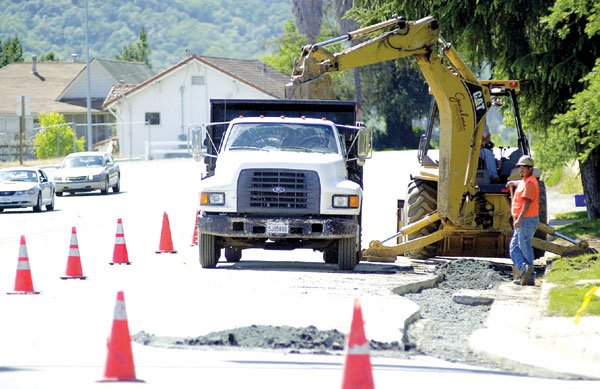GILROY
– Santa Teresa Boulevard is due for a new coat of asphalt this
summer, but until then, one can expect the
”
ka-chunk, ka-chunk
”
sound of wheels hitting potholes, cracks and patches to
continue.
GILROY – Santa Teresa Boulevard is due for a new coat of asphalt this summer, but until then, one can expect the “ka-chunk, ka-chunk” sound of wheels hitting potholes, cracks and patches to continue.
The dips from First Street to Longmeadow Drive range from mere cracks to full-fledged potholes several inches deep. One is a patched trench where utility wires were moved below ground from their aerial poles. While the trench is recent, the potholes have been there for some time.
“That’s one of the reasons why we’re rebuilding the whole road,” City Traffic Engineer Kristi Abrams said. “It’ll look like a brand new road when they’re done.”
The city is totally reconstructing northern Santa Teresa from First through Longmeadow – widening, moving utilities underground and, finally, repaving. On April 22, city officials are scheduled to open sealed bids for paving the boulevard, a job that will probably begin in July, City Inspector Jim Maestri said.
City officials expect a new paving design to prevent potholes on the boulevard for decades to come, Abrams said in January.
Meanwhile, the rough road annoys some locals. Many, however, say it’s no big deal.
At South Valley National Bank Thursday, on the corner of Santa Teresa and First, four out of five people said the uneven road doesn’t bother them. All five said they drive the boulevard regularly.
“I haven’t noticed any potholes – some little divots, but nothing major,” said bank clerk Gwen Watson, who drives Santa Teresa every day while commuting to and from her home in Morgan Hill.
“I don’t notice it too much,” said fellow clerk Shelly Olson, of Gilroy. “There are potholes, but you just get used to them after a while.”
But Financial Analyst Claudia Clark disagreed with her colleagues.
“You can’t help but notice them,” she countered. “I drive from Morgan Hill to Gilroy and back every day, and they’re terrible coming into Gilroy.”
On Thursday, workers hired by Verizon were digging a trench along the west edge of Santa Teresa where they will lay phone lines. The city recently finished digging a trench for Pacific Gas & Electric’s electric lines and Charter Communications’ cable, but Verizon wanted to dig its own, Maestri said.
The city has now finished work and turned its trench over to PG&E, which will pull and splice its lines from Welburn Avenue to First Street next week, Maestri said. PG&E already laid the line from Longmeadow to Welburn.
In one of the last jobs, PG&E will take down the utility poles that now line Santa Teresa.
Mayor Al Pinheiro, then a city councilman, made the original motion to put Santa Teresa power lines underground, a $850,000 project.
“It wasn’t going to be a very nice thing to have a brand-new boulevard and have those poles you have to move five feet or something,” Pinheiro said Thursday.
Santa Teresa isn’t the only part of town where utility poles will soon be banished. In two weeks, Maestri said, the city will begin putting power, phone and cable lines underground on Fifth Street downtown, from Eigleberry Street across Monterey Street to the railroad tracks.
In addition to removing the overhead eyesores, Maestri said it is an opportunity to upgrade the electrical system and rebuild traffic signals at Fifth and Monterey – all part of the Monterey Streetscape project currently under way.
In the nine months since the Santa Teresa project began, road work in general has abounded in Gilroy. In the winter, a city-hired contractor patched cracked pavement on Wren Avenue at the same time as a crew hired by PG&E dug up First, Second and Hanna streets to extend a gas line from the Second-and-Monterey intersection to First and Wren.
Now, those streets bear dark black squares of pavement where the holes once were.
With funds cut back due to the state budget crisis, city engineers opted to patch Wren’s deteriorated pavement instead of repave it entirely, according to Mike Goodhue, the city’s senior civil engineer.
“There will be seams” where the patches meet the old blacktop, Abrams said in January. “It won’t be smooth like a new road, but it’ll be pretty smooth.”
In the past, the city had problems with patches sagging over time due to utility companies’ slipshod patchwork, Abrams said. Three or four years ago, the City Council passed a law requiring contractors to fill any hole with a “slurry” of concrete before patching it.














